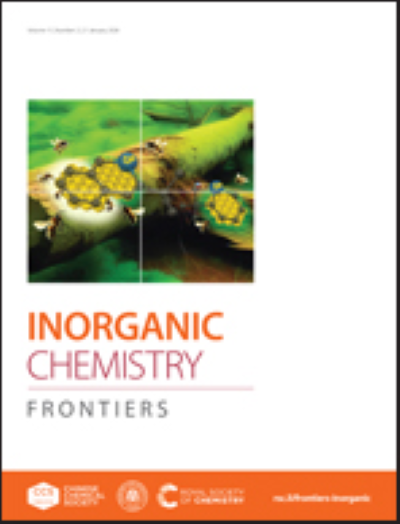Tailoring High Entropy Borides for Hydrogenation: Crystal Morphology and Catalytic Pathways
IF 6.1
1区 化学
Q1 CHEMISTRY, INORGANIC & NUCLEAR
引用次数: 0
Abstract
The high entropy boride (HEB) Al0.2Nb0.2Pt0.2Ta0.2Ti0.2B2, with its unique crystal structure and high coordination (platinum coordinated to 12 borons), has been shown in our previous work to exhibit exceptional catalytic properties, especially in sulfur-rich environments, where traditional platinum catalysts would succumb to sulfur-poisoning. In this work, we investigate the mechanism of the HEB catalyst, first by comparing the synthesis by flux growth, as previously reported, to an arc melted preparation. It is evident that the aluminum flux growth synthesis encourages the growth of single crystals, with clear and defined crystal facets, whereas the arc melted sample results in poorly defined facets with non-uniform morphology. Here, we explore two potential mechanisms: hydrogen spillover effect (HSPE) and hydrogen atom transfer (HAT) by which the catalytic pathway is performed. Hydrogenation reactions were performed using WO3 and 2,2,6,6-tetramethyl-1-piperidinyloxyl (TEMPO), which highlight the ability of the heterogeneous HEB catalyst to perform the hydrogenation through a suspended solid solution in addition to a dissolved solution. We propose that the HEB Al0.2Nb0.2Pt0.2Ta0.2Ti0.2B2 goes through a hybrid HAT/HSPE mechanism, where H2 bonds to the platinum atoms on the edges of the HEB, dissociate, then the radical hydrogen departs to the substrate.定制用于氢化的高熵硼化物:晶体形态和催化途径
高熵硼化物(HEB) Al0.2Nb0.2Pt0.2Ta0.2Ti0.2B2,具有独特的晶体结构和高配位(铂与12个硼配位),在我们之前的工作中已经显示出非凡的催化性能,特别是在富硫环境中,传统的铂催化剂会屈服于硫中毒。在这项工作中,我们研究了HEB催化剂的机理,首先通过比较通量生长合成,如之前报道的,电弧熔化制备。很明显,铝熔剂生长合成促进了单晶的生长,具有清晰而明确的晶面,而电弧熔化样品则导致晶面不清晰,形貌不均匀。在这里,我们探讨了两种潜在的机制:氢溢出效应(HSPE)和氢原子转移(HAT),通过催化途径进行。用WO3和2,2,6,6-四甲基-1-胡椒酰氧基(TEMPO)进行了加氢反应,这突出了多相HEB催化剂除了通过溶解溶液外,还可以通过悬浮固溶体进行加氢反应的能力。我们认为HEB Al0.2Nb0.2Pt0.2Ta0.2Ti0.2B2通过HAT/HSPE混合机制,H2与HEB边缘的铂原子结合,解离,然后自由基氢离开到底物。
本文章由计算机程序翻译,如有差异,请以英文原文为准。
求助全文
约1分钟内获得全文
求助全文
来源期刊

Inorganic Chemistry Frontiers
CHEMISTRY, INORGANIC & NUCLEAR-
CiteScore
10.40
自引率
7.10%
发文量
587
审稿时长
1.2 months
期刊介绍:
The international, high quality journal for interdisciplinary research between inorganic chemistry and related subjects
 求助内容:
求助内容: 应助结果提醒方式:
应助结果提醒方式:


